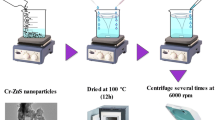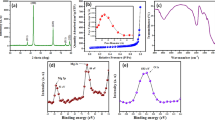Abstract
The current study is centered on the application of Ca doped CuO nanoparticles (NPs) made by a simple chemical precipitation method for aquaculture wastewater treatment. X-ray diffraction (XRD) and scanning electron microscopy (SEM) were used to analyze the phase, crystallite size, and morphological characteristics of the produced Ca doped CuO nanoparticles. XRD results demonstrated that the pristine and Ca doped CuO nanoparticles (0.5wt%, 2wt%, 4wt%) exhibited a crystallite size of 10–12 nm. As seen by FE-SEM, the nanoparticles were rice grain shaped. X-ray photoelectron spectroscopy revealed the binding energies for Cu at 933.6 and 953.7 eV, for O at 529.4 and 532.1 eV, and for Ca at 347.3 and 350.2 eV. The FTIR results demonstrated the characteristic peaks for Cu-O vibration modes at 426, 500, and 610 cm− 1. The antibacterial effectiveness of the fabricated materials was examined using the disc diffusion method against Gram-negative bacteria found in aquatic fish (Aeromonas salmonicida strain MTCC 1522). This assay showed that 0.5 wt% Ca doped CuO nanoparticles exhibited excellent antibacterial activity, wherein the zone of inhibition (ZOI) was found to be 25.5 ± 0.20 mm compared to pristine CuO NPs with 15 ± 0.46 mm ZOI. The production of ROS, which induces bacterial cell wall breakage, is the reason for the high antibacterial efficiency of fabricated materials. It causes the contents of the cell to leak out, eventually leading to cell death. Taking into account the simple synthesis technique and effective antibacterial efficacy of Ca doped CuO NPs, our results suggest that this material has a good prospect for use in wastewater purification.





Similar content being viewed by others
Abbreviations
- E. coli :
-
Escherichia coli
- L. pneumophila :
-
Legionella pneumophila
- V. cholera :
-
Vibrio cholera
- AOPs:
-
Advanced Oxidation Processes
- ROS:
-
Reactive Oxygen Species
- NPs:
-
Nanoparticles
- C. bonducella :
-
Caesalpinia bonducella
- S. aureus :
-
Staphylococcus aureus
- S. epidermidis :
-
Staphylococcus epidermidis
- P. aeruginosa :
-
Pseudomonas aeruginosa
- S. maltophilia :
-
Stenotrophomonas maltophilia
- E. faecalis :
-
Enterococcus faecalis
- S. mutans :
-
Streptococcus mutans
- K. pneumoniae :
-
Klebsiella pneumonia
- A. salmonicida :
-
Aeromonas salmonicida
- C. albicans :
-
Candida albicans
- MTCC:
-
Microbial Type Culture Collection and Gene Bank
- AR:
-
Analytical Research
- M:
-
molar
- oC:
-
degree Celcius
- Wt%:
-
weight%
- XRD:
-
X-ray diffraction
- SEM:
-
Scanning Electron Microscope
- FT-IR:
-
Fourier Transform Infrared
- XPS:
-
X-ray photoelectron spectroscopy
- LB:
-
Luria Bertani
- eV:
-
electron volt
- kV:
-
kilovolt
- mA:
-
Milliampere
- RPM:
-
Revolutions per minute
- ICAR:
-
Indian Council of Agricultural Research
- min:
-
minutes
- µL:
-
microlitre
- mm:
-
millimeter
- nm:
-
nanometer
- EDAX:
-
Energy dispersive X-Ray
- mg:
-
milligram
- ZOI:
-
Zone of Inhibition
References
Abou Hammad AB, Mansour AM, Cao F, El Nahrawy AM (2021) Effect of Calcination temperature on the optical and magnetic Properties of NiFe2O4-KFeO2 nanocomposite Films synthesized via WOSW Sol-Gel Route for Opto-Magnetic applications. ECS J Solid State Sci Technol 10(10):103016. https://doi.org/10.1149/2162-8777/ac31d2
Abou Hammad AB, Mansour AM, El Nahrawy AM (2021) Ni2 + doping effect on potassium barium titanate nanoparticles: enhancement optical and dielectric properties. Phys Scr 96(12):125821. https://doi.org/10.1088/1402-4896/ac25a6
Ahmad R, Ahmad Z, Khan AU, Mastoi NR, Aslam M, Kim J (2016) Photocatalytic systems as an advanced environmental remediation: recent developments, limitations and new avenues for applications. J Environ Chem Eng 4(4):4143–4164. https://doi.org/10.1016/j.jece.2016.09.009
Ashbolt NJ (2015) Microbial contamination of drinking water and human health from community water systems. Curr Environ Health Rep 2(1):95–106. https://doi.org/10.1007/s40572-014-0037-5
Borges ME, Sierra M, Cuevas E, García RD, Esparza P (2016) Photocatalysis with solar energy: sunlight-responsive photocatalyst based on TiO2 loaded on a natural material for wastewater treatment. Sol Energy 135:527–535. https://doi.org/10.1016/j.solener.2016.06.022
Cruz M, Gomez C, Duran-Valle CJ, Pastrana-Martínez LM, Faria JL, Silva AM, Faraldos M, Bahamonde A (2017) Bare TiO2 and graphene oxide TiO2 photocatalysts on the degradation of selected pesticides and influence of the water matrix. Appl Surf Sci 416:1013–1021. https://doi.org/10.1016/j.apsusc.2015.09.268
Deokar AR, Shalom Y, Perelshtein I, Perkas N, Gedanken A, Banin E (2016) A topical antibacterial ointment made of Zn-doped copper oxide nanocomposite. J Nanopart Res 18(8):1–6. https://doi.org/10.1007s11051-016-3534-7
Din SU, Sajid M, Imran M, Iqbal J, Shah BA, Shah S (2019) One step facile synthesis, characterization and antimicrobial properties of Mg-doped CuO nanostructures. Mater res Express 6(8):085022. https://doi.org/10.1088/2053-1591/ab1c1a
Dutta RK, Nenavathu BP, Gangishetty MK, Reddy AV (2012) Studies on antibacterial activity of ZnO nanoparticles by ROS induced lipid peroxidation. Colloids Surf B: Biointerfaces 94:143–150. https://doi.org/10.1016/j.colsurfb.2012.01.046
El Nahrawy AM, Abou Hammad AB, Youssef AM, Mansour AM, Othman AM (2019) Thermal, dielectric and antimicrobial properties of polystyrene-assisted/ITO: Cu nanocomposites. Appl Phys A 125(1):1–9. https://doi.org/10.1007/s00339-018-2351-5
El Nahrawy AM, Bakr AM, Hammad AB, Hemdan BA (2020) High performance of talented copper/magneso-zinc titanate nanostructures as biocidal agents for inactivation of pathogens during wastewater disinfection. Appl Nanosci 10(9):3585–3601. https://doi.org/10.1007/s13204-020-01454-3
El Nahrawy AM, Hemdan BA, Ali AI, Youssef AM, Hammad AB (2021) Sol-gel preparation of bioactive nanoporous (Al2O3: CuO: SiO2): dielectric properties and wastewater decontamination. Int J Mater Eng Innov 12(1):37–55. https://doi.org/10.1504/IJMATEI.2021.113216
El Nahrawy AM, Hemdan BA, Mansour AM, Elzwawy A, Abou Hammad AB (2021) Integrated use of nickel cobalt aluminoferrite/Ni2+ nano-crystallites supported with SiO2 for optomagnetic and biomedical applications. Mater Sci Eng B 274:115491. https://doi.org/10.1016/j.mseb.2021.115491
El Nahrawy AM, Mansour AM, Abou Hammad AB, Wassel AR (2018) Effect of Cu incorporation on morphology and optical band gap properties of nano-porous lithium magneso-silicate (LMS) thin films. Mat Res Exp 6(1):016404. https://doi.org/10.1088/2053-1591/aae343
El Nahrawy AM, Mansour AM, Bakr AM, Abou Hammad AB (2021) Terahertz and UV–VIS spectroscopy evaluation of copper doped zinc magnesium titanate nanoceramics prepared via sol-gel method. ECS J Solid State Sci Technol 10(6):063007. https://doi.org/10.1149/2162--8777/ac07f9
Elango M, Deepa M, Subramanian R, Mohamed Musthafa A (2018) Synthesis, characterization, and antibacterial activity of polyindole/Ag–Cuo nanocomposites by reflux condensation method. Polym Plast Technol Eng 57(14):1440–1451. https://doi.org/10.1080/03602559.2017.1410832
Eshed M, Lellouche J, Gedanken A, Banin E (2014) A zn doped CuO nanocomposite shows enhanced antibiofilm and antibacterial activities against streptococcus mutans compared to nanosized CuO. Adv Funct Mater 24(10):1382–1390. https://doi.org/10.1002/adfm.201302425
Fish K, Osborn AM, Boxall JB (2017) Biofilm structures (EPS and bacterial communities) in drinking water distribution systems are conditioned by hydraulics and influence discolouration. Sci Total Environ 593:571–580. https://doi.org/10.1016/j.scitotenv.2017.03.176
Grass G, Rensing C, Solioz M (2011) Metallic copper as an antimicrobial surface. Appl Environ Microbiol 77(5):1541–1547. https://doi.org/10.1128/AEM.02766-10
Hemdan BA, El Nahrawy AM, Mansour AF, Hammad AB (2019) Green sol–gel synthesis of novel nanoporous copper aluminosilicate for the eradication of pathogenic microbes in drinking water and wastewater treatment. Environ Sci Pollut Res 26(10):9508–9523. https://doi.org/10.1007/s11356-019-04431-8
Jiang J, Wang H, Chen X, Li S, Xie T, Wang D, Lin Y (2017) Enhanced photocatalytic degradation of phenol and photogenerated charges transfer property over BiOI-loaded ZnO composites. J Colloid Interface Sci 494:130–138. https://doi.org/10.1016/j.jcis.2017.01.064
Kaur N, Kaur S, Singh V (2016) Preparation, characterization and photocatalytic degradation kinetics of reactive red dye 198 using N, Fe codoped TiO2 nanoparticles under visible light. Desalin Water Treat 57(20):9237–9246. https://doi.org/10.1080/19443994.2015.1027956
Kayani ZN, Aslam H (2021) Investigation of structural, optical, antibacterial, and dielectric properties of V-doped copper oxide thin films: comparison with undoped copper oxide thin films. Adv Powder Technol 32(7):2345–2358. https://doi.org/10.1016/j.apt.2021.05.026
Liang CZ, Sun SP, Li FY, Ong YK, Chung TS (2014) Treatment of highly concentrated wastewater containing multiple synthetic dyes by a combined process of coagulation/flocculation and nanofiltration. J Membr Sci 469:306–315. https://doi.org/10.1016/j.memsci.2014.06.057
Malka E, Perelshtein I, Lipovsky A, Shalom Y, Naparstek L, Perkas N, Patick T, Lubart R, Nitzan Y, Banin E, Gedanken A (2013) Eradication of multi drug resistant bacteria by a novel Zn doped CuO nanocomposite. Small 9(23):4069–4076. https://doi.org/10.1002/smll.201301081
Mansour AM, Hemdan BA, Elzwawy A, Abou Hammad AB, El Nahrawy AM (2022) Ecofriendly synthesis and characterization of Ni2+ codoped silica magnesium zirconium copper nanoceramics for wastewater treatment applications. Sci Rep 12(1):1–7. https://doi.org/10.1038/s41598-022-13785-y
Mersian H, Alizadeh M, Hadi N (2018) Synthesis of zirconium doped copper oxide (CuO) nanoparticles by the Pechini route and investigation of their structural and antibacterial properties. Ceram Int 44(16):20399–20408. https://doi.org/10.1016/j.ceramint.2018.08.033
Pugazhendhi A, Kumar SS, Manikandan M, Saravanan M (2018) Photocatalytic properties and antimicrobial efficacy of Fe doped CuO nanoparticles against the pathogenic bacteria and fungi. Microb Pathog 122:84–89. https://doi.org/10.1016/j.micpath.2018.06.016
Ravi S, Shashikanth FW (2015) Ferromagnetism in Mn doped copper oxide nanoflake like structures with high neel temperature. Mater Lett 141:132–134. https://doi.org/10.1016/j.matlet.2014.11.089
Sajid M, Imran M, Iqbal J (2018) Tailoring structural, surface, optical, and dielectric properties of CuO nanosheets for applications in high-frequency devices. Appl Phys A 124(11):1–8. https://doi.org/10.1007/s00339-018-2179-z
Sánchez-López E, Gomes D, Esteruelas G, Bonilla L, Lopez-Machado AL, Galindo R, Cano A, Espina M, Ettcheto M, Camins A, Silva AM (2020) Metal-based nanoparticles as antimicrobial agents: an overview. Nanomaterials 10(2):292. https://doi.org/10.3390/nano10020292
Sharma G, Kumar A, Naushad M, Pathania D, Sillanpää M (2016) Polyacrylamide@ zr (IV) vanadophosphate nanocomposite: ion exchange properties, antibacterial activity, and photocatalytic behavior. Ind Eng Chem Res 33:201–208. https://doi.org/10.1016/j.jiec.2015.10.011
Sharma M, Joshi M, Nigam S, Shree S, Avasthi DK, Adelung R, Srivastava SK, Mishra YK (2019) ZnO tetrapods and activated carbon based hybrid composite: adsorbents for enhanced decontamination of hexavalent chromium from aqueous solution. Chem Eng J 358:540–551. https://doi.org/10.1016/j.cej.2018.10.031
Siddiqi KS, Husen A (2018) Properties of zinc oxide nanoparticles and their activity against microbes. Nanoscale Res Lett 3(1):1–3. https://doi.org/10.1186/s11671-018-2532-3
Singh A, Nenavathu BP, Dasauni K, Kumar Nailwal T (2022) ROS-Mediated aquaculture Wastewater Remediation using TeO2-Deposited ZnO nanotubes. Water Air Soil Pollut 233(6):1–2. https://doi.org/10.1007/s11270-022-05668-9
Singh A, Nenavathu BP, Mohsin M (2021) Facile synthesis of Te-doped ZnO nanoparticles and their morphology-dependent antibacterial studies. Chem Pap 75(8):4317–4326. https://doi.org/10.1007/s11696-021-01654-3
Singh BP, Chaudhary M, Kumar A, Singh AK, Gautam YK, Rani S et al (2020) Effect of Co and Mn doping on the morphological, optical and magnetic properties of CuO nanostructures. Solid State Sci 106:106296. https://doi.org/10.1016/j.solidstatesciences.2020.106296
Sukumar S, Rudrasenan A, Padmanabhan Nambiar D (2020) Green-synthesized rice-shaped copper oxide nanoparticles using Caesalpinia bonducella seed extract and their applications. ACS omega 5(2):1040–1051. https://doi.org/10.1021/acsomega.9b02857
Sundar S, Venkatachalam G, Kwon SJ (2018) Biosynthesis of copper oxide (CuO) nanowires and their use for the electrochemical sensing of dopamine. Nanomaterials 8(10):823. https://doi.org/10.3390/nano8100823
Tamgadge YS, Talwatkar SS, Sunatkari AL, Pahurkar VG, Muley GG (2015) Studies on nonlocal optical nonlinearity of Sr–CuO–polyvinyl alcohol nanocomposite thin films. Thin Solid Films 595:48–55. https://doi.org/10.1016/j.tsf.2015.10.039
Tran HT, Kosslick H, Ibad MF, Fischer C, Bentrup U, Vuong TH, Nguyen LQ, Schulz A (2017) Photocatalytic performance of highly active brookite in the degradation of hazardous organic compounds compared to anatase and rutile. Appl Catal B 200:647–658. https://doi.org/10.1016/j.apcatb.2016.07.017
Zhu B, Liu B, Qu C, Zhang H, Guo W, Liang Z, Chen F, Zou R (2018) Tailoring biomass-derived carbon for high-performance supercapacitors from controllably cultivated algae microspheres. J Mater Chem A 6(4):1523–1530. https://doi.org/10.1039/C7TA09608A
Acknowledgements
The authors are grateful for the infrastructure provided by Indira Gandhi Delhi Technical University for Women. Ms. Saumya is grateful for the junior research fellowship she received from the Indira Gandhi Delhi Technical University for Women. The authors would like to thank Jamia Millia Islamia’s Centre for Nanoscience and Nanotechnology, New Delhi for providing the instrumental facilities.
Author information
Authors and Affiliations
Corresponding author
Ethics declarations
Declaration of conflict of interest
The authors declare that they have no known competing financial interests or personal relationships that could have appeared to influence the work reported in this paper.
Additional information
Publisher’s note
Springer Nature remains neutral with regard to jurisdictional claims in published maps and institutional affiliations.
Rights and permissions
Springer Nature or its licensor (e.g. a society or other partner) holds exclusive rights to this article under a publishing agreement with the author(s) or other rightsholder(s); author self-archiving of the accepted manuscript version of this article is solely governed by the terms of such publishing agreement and applicable law.
About this article
Cite this article
Saumya, Dasauni, K., Nailwal, T.K. et al. Facile synthesis of Ca doped CuO nanoparticles and their investigation in antibacterial efficacy. Biologia 78, 903–911 (2023). https://doi.org/10.1007/s11756-022-01303-4
Received:
Accepted:
Published:
Issue Date:
DOI: https://doi.org/10.1007/s11756-022-01303-4




